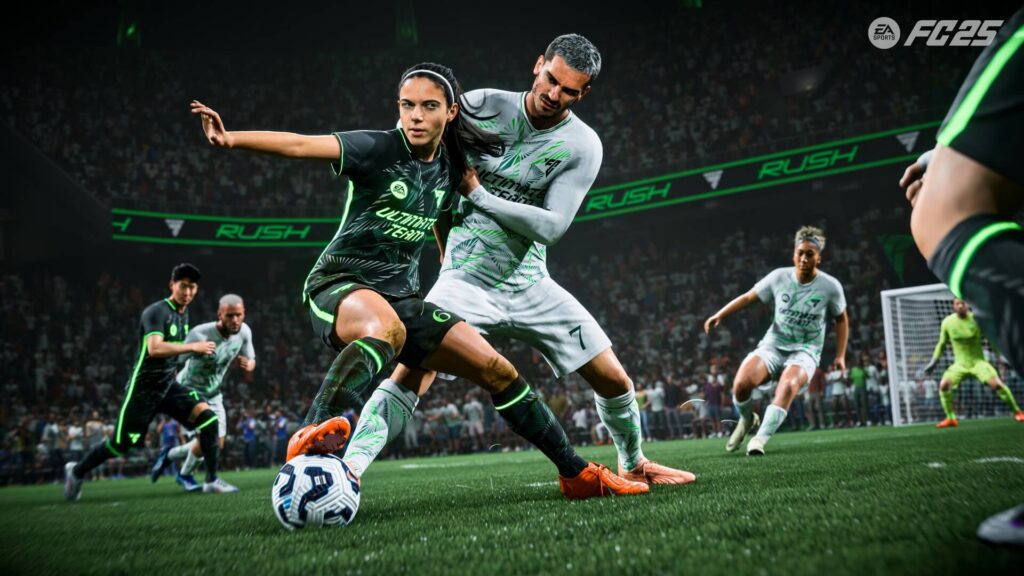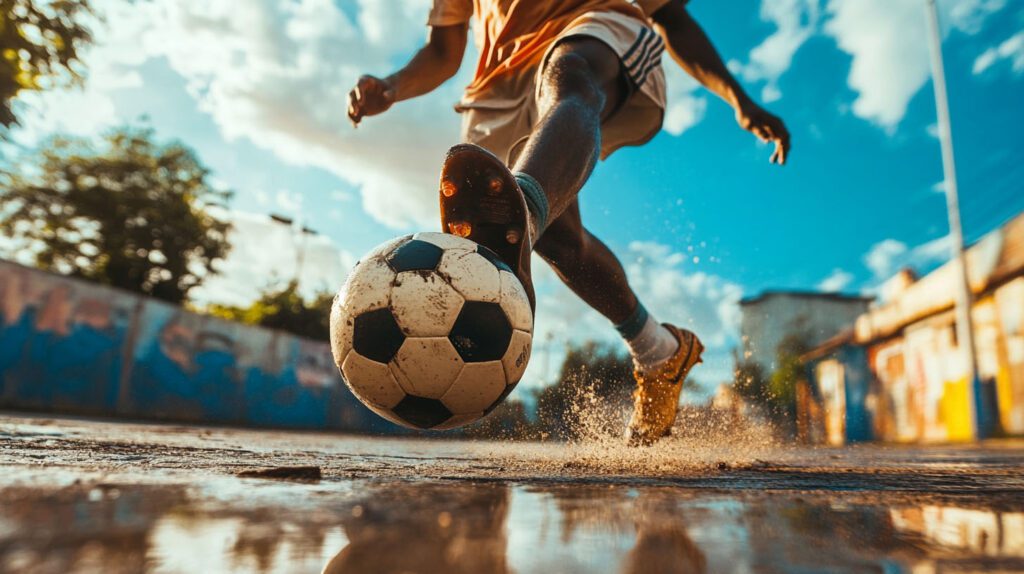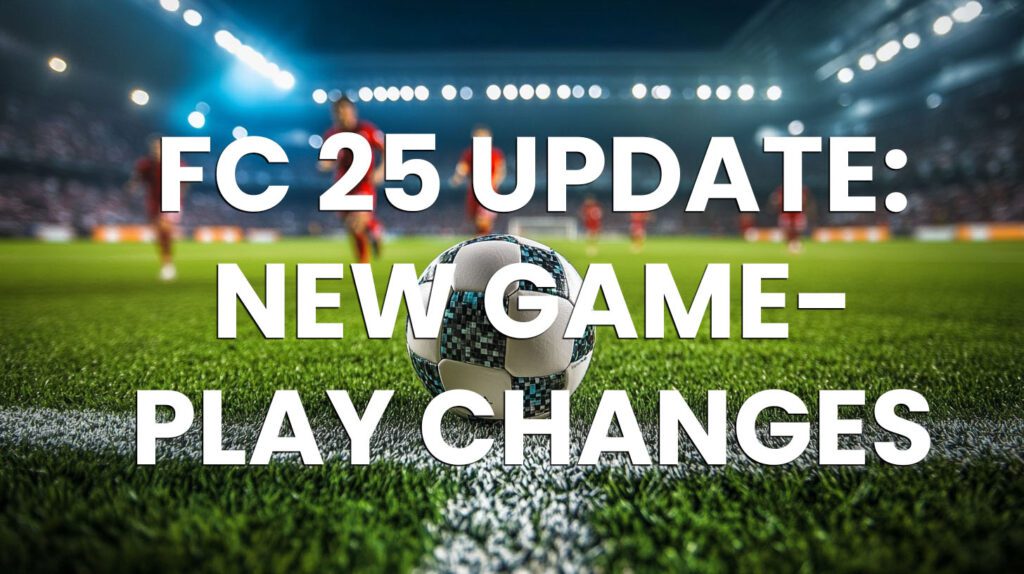Dribbling is an essential skill in FIFA 25, and learning how to maneuver like a professional player can give you a significant edge over your opponents. Whether you’re a beginner or an experienced player, understanding the fundamentals of dribbling will improve your gameplay. This guide will walk you through the key dribbling techniques in FIFA 25 and provide tips for mastering them to dominate in higher divisions.
First Touch: The Foundation of Successful Dribbling
Your first touch sets the stage for every movement that follows. It’s critical to take your first touch into the space available to maintain control and avoid losing possession. As demonstrated in live gameplay, if you take a risky first touch into an area where your opponent is present, you’re likely to lose the ball. Instead, always aim to move the ball into open space, even if it means passing backward.
For instance, when you see a gap, take your first touch into that space, away from defenders. This approach helps maintain ball control and gives you more time to assess your next move. In FIFA 25, this fundamental step can mean the difference between keeping possession and turning the ball over.
Strafe Dribbling: The New Meta for Quick Movements
Strafe dribbling is one of the most effective ways to maneuver around defenders in FIFA 25. Holding the L1 button while using the left stick allows your player to strafe and move sideways with the ball, making it harder for defenders to predict your next move. Combining strafe dribbling with a sprint boost, you can create opportunities to outplay your opponents, especially in tight situations.
This technique is particularly useful in higher divisions, where players are less likely to fall for basic skill moves. Strafe dribbling allows you to stay in control while waiting for your opponent to overcommit, enabling you to dart into open space when the opportunity arises.
Controlled Sprint: Balancing Speed with Precision
Controlled sprinting is another crucial dribbling technique in FIFA 25. It’s a balanced form of sprinting, allowing you to move faster while still maintaining control of the ball. To activate controlled sprinting, hold the R1 button. Unlike regular sprinting, which can cause you to lose control, controlled sprinting gives you better precision, especially when navigating through crowded areas.
However, it’s essential to know when to use controlled sprinting. Using it in your own half or in high-pressure situations can lead to turnovers. Instead, use it when you have space to exploit, as it allows you to move more fluidly without sacrificing control.
For more detailed instructions on dribbling techniques in FIFA 25, visit FIFA School, where you can find comprehensive tutorials and gameplay tips.
Left Stick Dribbling: Mastering the Basics
Left stick dribbling remains one of the simplest but most effective ways to dribble in FIFA 25. It allows you to take small, precise touches that help maintain possession, especially in tight spaces. Top players combine left stick dribbling with other techniques, such as controlled sprinting and strafe dribbling, to keep defenders off balance.
The key to left stick dribbling is knowing when to turn. In many cases, turning away from your opponent rather than toward them can prevent losing the ball. Waiting for your opponent to overcommit and then turning into open space is a highly effective strategy. Remember, the more agile the player, the smoother the dribbling, which brings us to the next point.
Player Attributes: Height, Agility, and Balance
A player’s dribbling performance is significantly affected by their attributes, especially height, agility, and balance. Shorter players, such as Sam Kerr (5’4″), tend to feel more agile and responsive on the ball. Even if a taller player has high agility and balance stats, they will still feel less fluid in comparison.
For example, players like De Jong, who stands over 6 feet tall, will feel clunkier when dribbling despite high agility stats. On the other hand, shorter players, regardless of slightly lower stats, will feel more “liquid” on the ball, making them ideal for dribbling. As a general rule, prioritize players with high agility and balance for better control during dribbling.
Advanced Dribbling: Ball Roll and Shielding Techniques
In FIFA 25, the ball roll is one of the most effective moves for turning away from defenders. By holding the right stick in the direction you want to roll, you can quickly change the direction of play while maintaining possession. This is especially useful inside the box when trying to set up a shot.
Additionally, shielding the ball with your body is another essential skill. Instead of relying solely on the L2 button to shield the ball, use your natural body positioning. For instance, when a defender is pressuring you from behind, turn your body away from them to protect the ball. This technique can help you maintain possession and create space for your next move.
Knowing When to Sprint: The Biggest Mistake
One of the biggest mistakes players make is overusing the sprint button, especially in their own half. Sprinting reduces control over the ball, and while it may work against less experienced players, it’s not a reliable tactic at higher levels. The more you sprint, the easier it is for skilled defenders to predict your moves and intercept the ball.
Top players in FIFA 25 use sprinting sparingly and in strategic moments. Instead of constantly sprinting, focus on controlled dribbling, waiting for gaps to open up before using your speed to burst through. This approach will help you retain possession and outplay even the toughest defenders.
FAQs on Dribbling in FIFA 25
1. What is the most effective dribbling technique in FIFA 25?
The most effective dribbling techniques include strafe dribbling, controlled sprinting, and left stick dribbling. Combining these techniques with good decision-making will help you maintain control and outmaneuver opponents.
2. How do I improve my dribbling in FIFA 25?
Focus on mastering the basics like first touch and left stick dribbling. Use techniques like strafe dribbling and controlled sprinting to gain an advantage in tight spaces. Practice regularly in-game to develop a better feel for different players’ dribbling styles.
3. Does player height affect dribbling in FIFA 25?
Yes, player height has a significant impact on dribbling. Shorter players are generally more agile and responsive on the ball, making them better for dribbling. Taller players, even with high agility stats, can feel clunky in comparison.
4. What is the best way to shield the ball in FIFA 25?
Instead of relying solely on the L2 button, use your body to shield the ball naturally. Position yourself so that your opponent can’t easily reach the ball, and turn away from defenders to protect possession.
5. Why shouldn’t I sprint all the time in FIFA 25?
Sprinting reduces control over the ball and makes it easier for defenders to intercept. Use sprinting sparingly, only when there’s space to exploit, and rely more on controlled dribbling to maintain possession.
By understanding and applying these dribbling techniques, you can elevate your FIFA 25 gameplay and maneuver like a pro. Focus on mastering these basics, and you’ll be able to outplay opponents at any level.





